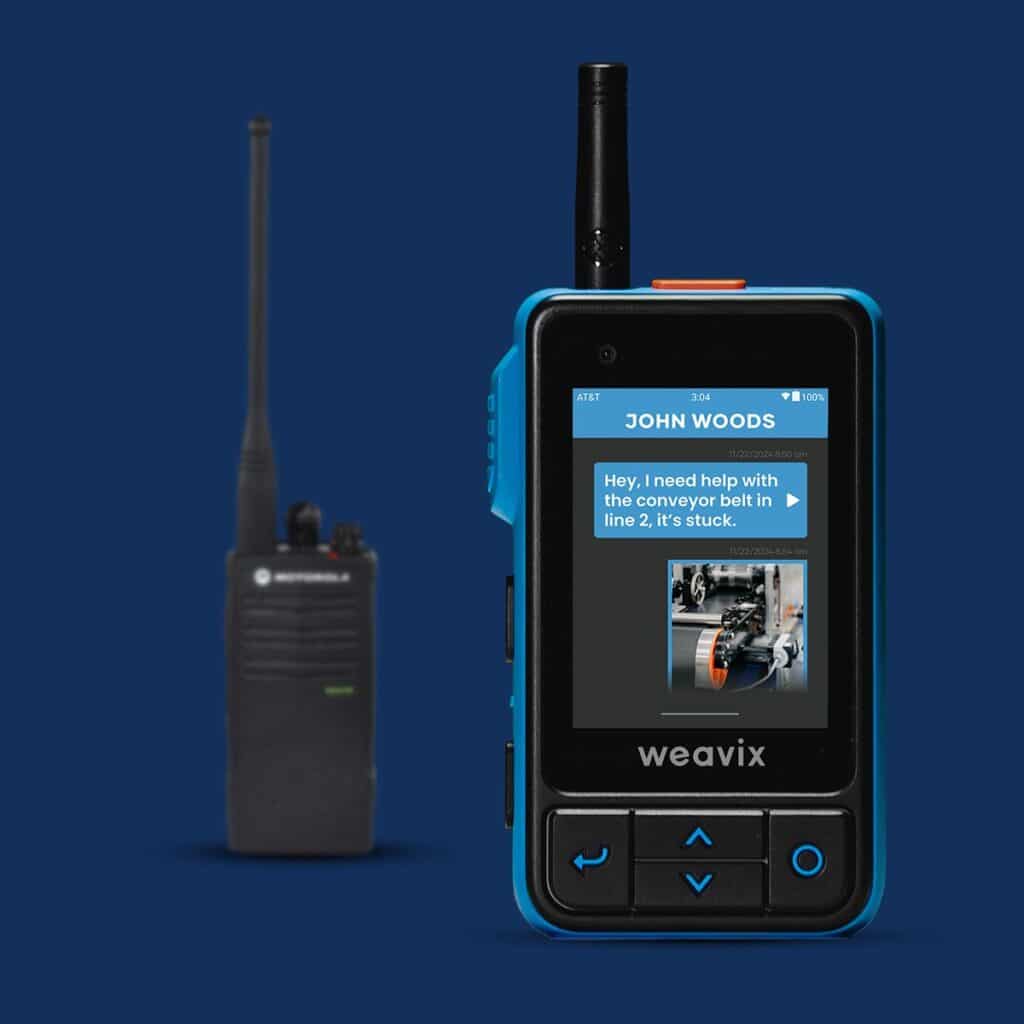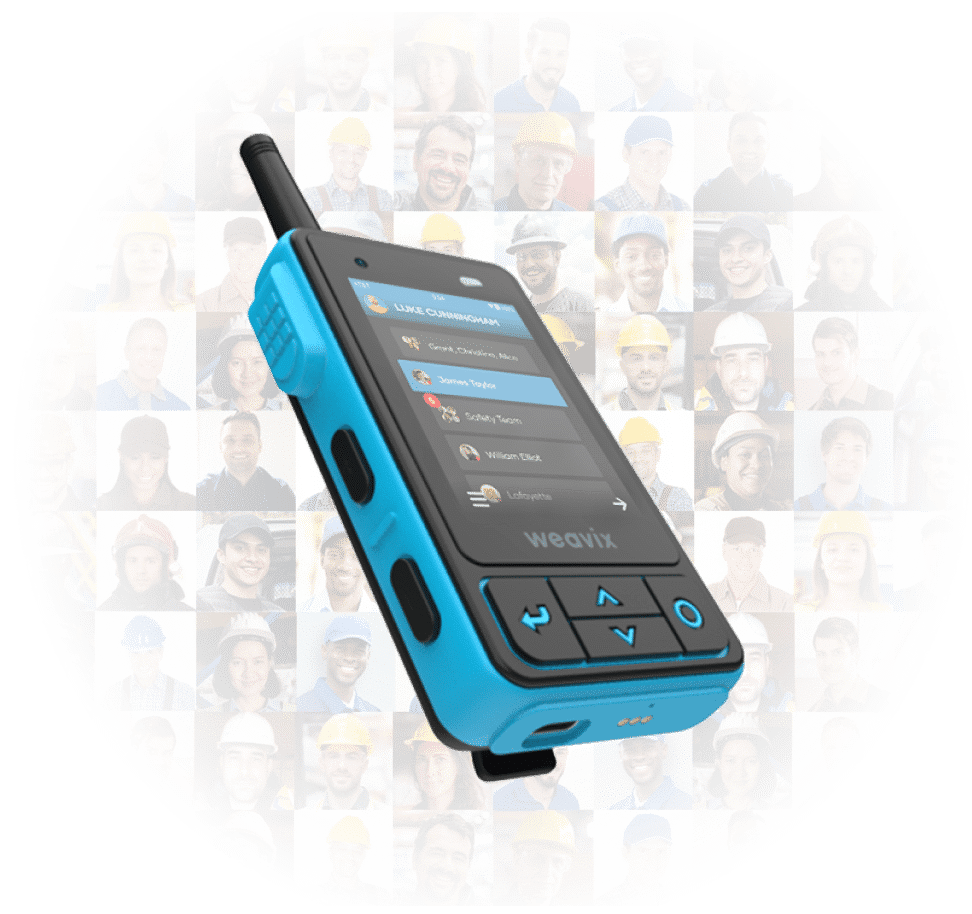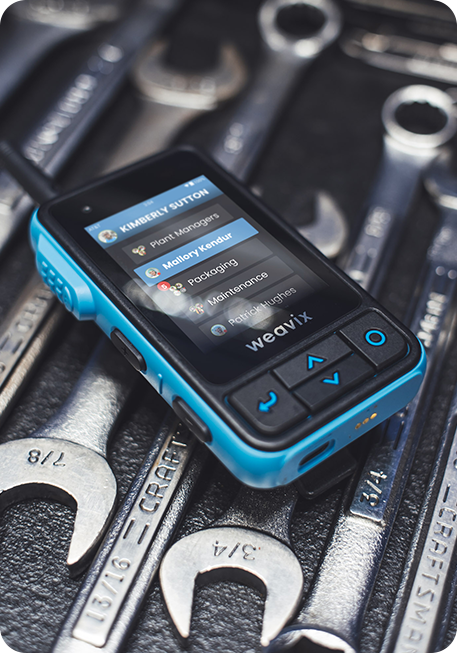Two-Way Radio Comparison: Walt vs Motorola RDX Series
Walt Smart Radio vs Motorola RDX Series
This Two-Way Radio Comparison between the Weavix Walt Smart Radio System and the Motorola RDX Series reveals how modern smart radios built for frontline enterprises deliver auditable communication, real-time data capture, and enterprise-grade safety where legacy push-to-talk devices fall short.
In this Two-Way Radio Comparison, Weavix demonstrates measurable ROI and improved communication accuracy.
See why Walt Smart Radio delivers enterprise-wide coverage, compliance-ready safety, and scalability without licenses or repeaters.

TL;DR
This Two-Way Radio Comparison between the Weavix Walt Smart Radio System and the Motorola RDX Series highlights the clear gap between enterprise smart radios and legacy RF devices.
Motorola RDX Series: Limited RF coverage, FCC-licensed channels, and basic safety functionality.
Walt Smart Radio System: Enterprise-wide LTE/Wi-Fi coverage, unlimited channels, no FCC license, and advanced SOS capability.
Key advantage: The Walt Smart Radio System removes repeaters and licensing barriers while adding multimedia, worker safety, and rugged, intrinsically safe design.
Bottom line: This Two-Way Radio Comparison shows the Weavix Walt Smart Radio System outmatches the Motorola RDX Series in performance, scalability, and total cost of ownership—making it the superior choice for frontline enterprises.
Why This Comparison Matters
The Motorola RDX Series has been trusted for years, but enterprises today demand safety, scalability, and compliance. This section explains why comparing RDX with Walt Smart Radio System matters for frontline teams making long-term communication investments.
Walt Smart Radio
Walt Smart Radio takes the best of radio durability and combines it with modern software-driven features, making it a scalable, safe, and cost-efficient alternative.
Motorola RDX Series
Motorola RDX Series radios have been widely used in frontline operations for years. They’re familiar, durable, and dependable — but they were designed for a world before enterprise-wide connectivity and cloud-based communications.
Key Manufacturing and Operational KPIs
Frontline operations judge communication tools by their measurable impact on productivity, safety, and compliance. The Motorola RDX Series delivers basic voice, while the Walt Smart Radio System turns conversations into operational data that improves outcomes across the board.
KPI | Walt Smart Radio System | Motorola RDX Series |
|---|---|---|
OEE | Improves via visibility + knowledge capture | No archival, no impact |
Downtime | 15–20% reduction | Not measurable |
MTTR | 20–30% faster repairs | Not measurable |
Shift Handoffs | Automated summaries | Manual notes only |
Rework | 15–25% fewer | Not measurable |
Onboarding | 40% faster | No support |
Compliance | Audit-ready logs | No transcripts |
This goes above your Feature Comparison table. That restores the full two-table structure the template requires.
Want me to now re-flow the RDX draft with this KPI table inserted and the other fixes (renames, Customer Proof, separators, Final Verdict) so you have the whole piece corrected in one shot?
Feature Comparison
A direct comparison shows whether a tool is just a rugged radio or a full communications platform. Walt Smart Radio System delivers transcription, translation, and compliance-ready records, while Relay devices stop at live voice.
Feature | Walt Smart Radio System | Motorola RDX Series |
|---|---|---|
Coverage | Nationwide LTE/Wi-Fi coverage + FRS backup + SimulCast | RF range limited to site; repeaters required for expansion |
Safety Features | SOS with ID, location, lone-worker protection, incident logging | Basic emergency alert tone |
Communication | Unlimited channels, group talk, private 1:1, multimedia (text, photo, video) | Voice-only, channel-limited |
Licensing | No FCC license required | Requires FCC license per channel |
Scalability | Enterprise-wide scalability; no repeaters needed | Repeaters required; separate systems per site |
Ruggedness | C1D2 intrinsically safe, IP68, dustproof, water-resistant, hardened touchscreen | Durable; IP54; not intrinsically safe |

Never Buy a Dumb Radio Again.
Equip your workers with the Walt Smart Radio System. Move beyond your perception of what a radio should do. Walt is more than a radio, it’s a frontline communication and safety platform that enables every worker.
>>>> Learn how the Walt Smart Radio System sets the standard for modern industrial communication.
Relay Pro vs Walt Smart Radio System: The Real Story
The Motorola RDX Series is reliable for small-scale operations but becomes costly and restrictive at enterprise scale. Each additional channel requires FCC licensing, and expanding coverage needs repeaters and infrastructure.
Walt Smart Radio eliminates those barriers — offering unlimited channels, nationwide coverage without repeaters, and advanced worker safety built in.
Coverage
Walt Smart Radio: LTE/Wi-Fi + FRS backup for true enterprise-wide reach.
RDX falls short:
RF coverage only; repeaters needed to cover larger facilities.
Safety
Walt Smart Radio: SOS alerts include worker identity, GPS location, and context, enabling faster response.
RDX falls short:
Emergency button triggers an alert tone but provides no ID or location.
Communication
Walt Smart Radio: Enables group talk, private 1:1 communication, and multimedia sharing.
RDX falls short:
Limited to push-to-talk voice channels.
Licensing & scalability
Walt Smart Radio: Scales across sites instantly with no repeaters or FCC licensing.
RDX falls short:
FCC licenses per channel and repeaters for expansion.
Ruggedness
Walt Smart Radio: Intrinsically safe (C1D2), IP68, drop-resistant, dustproof, water-resistant.
RDX falls short:
Built durable but lacks intrinsic safety certifications.

Customer Proof
Enterprises that outgrew legacy radios like the Motorola RDX Series chose the Walt Smart Radio System to modernize communication and capture measurable ROI.
Panasonic Energy: Reduced downtime in battery production lines by archiving voice and video troubleshooting. With RDX, conversations would vanish and repeat issues persisted.
MillerKnoll: Improved shift handoffs with automated transcripts and summaries. With RDX, workers relied on handwritten notes, creating errors and gaps.
Howard Industries: Moved beyond flip phones and basic radios to protect a 2.4 million square foot facility with scalable, intrinsically safe radios. With RDX, expansion required costly repeaters and FCC licensing.
Aspire Bakeries: Cut onboarding time for new hires by 40 percent using archived training conversations. With RDX, onboarding remained slow and inconsistent.
Shell: Rolled out communications across hazardous frontline zones with C1D2 intrinsic safety. With RDX, devices lacked certification, blocking deployment in critical areas.
A Trusted Partner in Frontline Enablement
Beyond Radios: Walt Smart Radio as a Frontline Communications Platform
Unlike the RDX Series, Walt Smart Radio isn’t limited to voice-only communication. It’s a platform that integrates safety, scalability, and workforce enablement — giving enterprises better ROI while protecting frontline workers.
The Motorola RDX Series remains a dependable legacy option, but its limitations in coverage, scalability, and safety make it costly and outdated for modern enterprises.
Walt Smart Radio is not just a replacement — it’s a frontline communications platform that lowers costs, improves safety, and scales across your entire operation.
Ready to see how Walt Smart Radio compares in your environment?

Frequently Asked Questions
Do Motorola RDX Series radios require FCC licenses?
Yes. Each channel requires licensing. Walt Smart Radio runs on LTE/Wi-Fi with no FCC license required.
Do RDX radios need repeaters?
Yes. Expanding coverage requires repeaters and separate systems for different sites. Walt Smart Radio provides enterprise-wide scalability without them.
How does Walt Smart Radio improve safety compared to RDX radios?
Instead of a basic tone, Walt Smart Radio provides SOS alerts with worker ID, location, and incident logging.
Is Walt Smart Radio rugged enough for industrial use?
Yes. Walt Smart Radio is intrinsically safe (C1D2), IP68, dustproof, water-resistant, and drop resistant with a hardened touchscreen.




